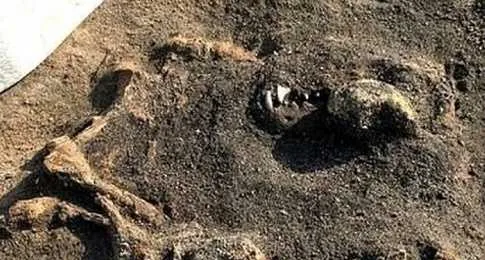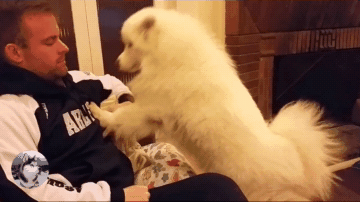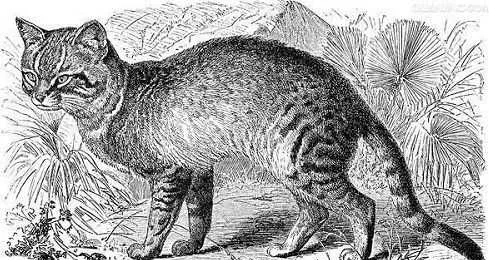犬與貓:從冰河時代走來的末世戰友vs主動選擇蹭吃蹭喝的佛系室友
在最後一次冰河時代(末次冰盛期LGM)即將結束的某個時候,西伯利亞東北部的草原上一群已然長出鏟型門齒的人類手持石器追逐著長毛象,這只離群的大家夥驚恐地發現,自己的前方數只似狼非狼的生物早已鎖死了它的去路。

是的, 早在23000年前,被完全馴化的狗狗便與人類結伴而行 [1] [2] : 巡視、狩獵、與人類並肩而戰。 在那四分之一的世界被冰雪覆蓋的土地上,它們的足跡也伴隨人類向全世界擴散,有的留在歐亞大陸、有的伴隨主人一路漂洋過海到了美洲 [3] ,一萬年後,全世界都有了它們的蹤跡 [4] ——末次冰盛期限制了人口的增長,但並不阻礙人類與犬只進一步加深友誼—— 在那個低溫少雨的時代 [5] ,與犬類共謀生計的記憶可以說是刻進了我們的「骨子」裏。
(狗與狼確切分化約在20000-45000年前 [4] [6] ,狗可能起源於一個已滅絕的狼譜系)
在跟隨人類遷徙的同時,狗狗也為更適應人類產生了明確的前進演化: 讀懂人類的面部表情並感知他們的情緒 [7] [8] 、把之於人類的興奮反應在一個單獨的腦分區 [9] 、模仿人類的動作與行為 [10] [11] 甚至前進演化出控制眉眼的肌肉做出更豐富的表情來向人類撒嬌 [12] ...

心理學家Mary Ainsworth設計了依戀理論最重要的實驗「陌生環境實驗」(the Ainsworth Strange Situation) [13] [14] ,有不少學者在狗狗身上也做了這個實驗 [15] [16] ,得出的結論是 在與主人別離又重逢後,狗狗的表現類同於相同情況下嬰兒之於母親的行為。狗狗的行為舉止和心率等生理指標也與主人緊密關聯 [17] [18] 。
人類呢,也與狗狗產生了趨同前進演化 (Convergent Evolution,即源自不同祖先的生物,由於相似的生活方式,整體或部碎形態結構向著同一方向改變),一起變得更加擅長消化澱粉 [19] 。此外,一項研究表明 人與狗相互凝視會導致雙方產生類似於母親與嬰兒之間的那種激素反應 [20] 。

顯而易見,人與狗狗的紐帶跨越了時空與物種。
反觀貓咪,大約在一萬年前的新石器時代,位於中東新月沃土地帶的早期人類首先進入了農業定居時代,最早的谷物貯藏引來了家鼠,吃飽喝足的家鼠又引來了分布於中東的野貓亞種非洲野貓(F.s.lybica)。
隨著人類的聚居, 原先偏好獨居的野貓們在這個穩固的生態席位上演化成了具有一定社會性的家貓, 形成自己穩固的聚居群體 與人類共生 [21] [22] 。簡言之,相比被人類透過行為交流和指令誘導進行選擇的狗狗,貓咪是主動抱上了人類大腿 [23] [24] , 比起狗與人的從屬關系,貓咪更像是人類的室友。

盡管貓咪也前進演化出了 用喵喵叫這種暴露自己位置的行為取悅與呼喚人類的「語言」系統 [25] ,但 它們與人類的一些互動依然建立在它們樂意且沒厭煩的基礎上 (比如被撫摸這種「異體理毛行為」 [26] ,願意給你擼就給,不樂意或者厭煩了吭哧就一口)。

東京大學認知與行為科學學院和日本理化學研究所中心的科學家們在動物行為學期刊ANIMAL COGNITION上一篇文章 [27] ,他們研究了20只貓咪在家時之於自己主人和陌生人呼喚聲的反應,研究表明喵星人只會在聽到主人叫它們名字時才會抖動耳朵認真傾聽,而在陌生人叫它們時表現的無動於衷 (可悲的是,該調查中沒有一只貓會在聽到主人叫後,起身去尋找主人), 僅僅是向下動幾下耳朵,這表示「我在聽」。比起一被呼喚就彈射起步的狗狗,貓咪顯然沒用那麽熱情╮(╯▽╰)╭

當然,貓咪的性格分化比狗狗要大,生活中也不乏毛毛的粘人精~
試圖安慰自己點說,我家貓依然會每天蹲在門前,等待它唯一的、可以信賴的大英雄狩獵歸來。

末世主題的電影,往往充斥著著 物資匱乏、環境惡化、文明倒退、人類互相攻擊 等元素, 在一片危機四伏的土地上,一只更默契、忠誠且擁有一定撲咬與攜行能力的狗狗,自然還是要比貓咪靠譜許多,對吧?

對不起拿錯圖了Σ( ⚆൧⚆)

知乎日報收錄、官方微博推薦的零基礎養狗攻略:
日報專題雙收錄的手把手教你養貓工具文:
參考
- ^ Larson G , Bradley D G , Andersson L . How Much Is That in Dog Years? The Advent of Canine Population Genomics[J]. PLOS Genetics, 2014, 10(1):e1004093-.
- ^ Larson G , Bradley D G , Andersson L . How Much Is That in Dog Years? The Advent of Canine Population Genomics[J]. PLOS Genetics, 2014, 10(1):e1004093-.
- ^ Perri A R , Feuerborn T R , Frantz L , et al. Dog domestication and the dual dispersal of people and dogs into the Americas[J]. Proceedings of the National Academy of Sciences, 2021, 118(6).
- ^ a b Pavlidis P & Somel M., Science DOI: 10.1126/science.abe7823 (2020).
- ^ 葉佰生, 李世傑. 從末次冰盛期冰川規模探討當時的氣候環境[J]. 冰川凍土, 1997.
- ^ Laura R. Botigué, Song S , Scheu A , et al. Ancient European dog genomes reveal continuity since the Early Neolithic[J]. Nature Communications, 2017, 8:16082.
- ^ Custance D , Mayer J . Empathic-like responding by domestic dogs (Canis familiaris) to distress in humans: An exploratory study[J]. Animal Cognition, 2012, 15(5):851.
- ^ Natalia, Albuquerque, Kun, et al. Dogs recognize dog and human emotions[J]. Biology Letters, 2016, 12(1):20150883-20150883.
- ^ Shaw A . How dogs love us: A neuroscientist and his dog decode the canine brain. Gregory Berns[J]. Mpra Paper, 2015, 5(1):1-7.
- ^ Merola I , Prato-Previde E , Marshall-Pescini S . Social referencing in dog-owner dyads?[J]. Animal Cognition, 2011, 15(2):175-185.
- ^ Bowlby J . the dog-human bond[J]. Galody Com.
- ^ Kaminski J , Waller B M , D Rui, et al. Evolution of facial muscle anatomy in dogs[J]. Proceedings of the National Academy of Sciences, 2019, 116(29):201820653.
- ^ Ainsworth M , Blehar M C , Waters E , et al. Patterns of Attachment: A Psychological Study of the Strange Situation[J]. Lawrence Erlbaum Associates, 1978, 23.
- ^ Main M , Kaplan N , Cassidy J . Security in Infancy, Childhood, and Adulthood: A Move to the Level of Representation[J]. Monographs of the Society for Research in Child Development, 1985, 50(1/2):66-104.
- ^ Prato-Previde E , Custance D M , Spiezio C , et al. Is the dog-human relationship an attachment bond? An observational study using Ainsworth's strange situation[J]. Behaviour, 2003, 140(2):225-254.
- ^ Topál, József, Miklósi, ádám, Csányi, Vilmos, et al. Attachment Behavior in Dogs (Canis familiaris): A New Application of Ainsworth's (1969) Strange Situation Test[J]. Journal of Comparative Psychology, 1998, 112(3):219-229.
- ^ Palestrini C , Prato-Previde E , Custance D M , et al. Heart rate and behavioural responses of dogs (Canis familiaris) in the Ainsworth's Strange Situation Test: A pilot study. 2001.
- ^ Brubaker, Lauren, Udell, et al. Are Dogs Social Generalists? Canine Social Cognition, Attachment, and the Dog-Human Bond[J]. Current Directions in Psychological Science A Journal of the American Psychological Society, 2016.
- ^ Shannon L M , Boyko R H , Castelhano M , et al. Genetic structure in village dogs reveals a Central Asian domestication origin[J]. Proceedings of the National Academy of Sciences of the United States of America, 2015:13639-44.
- ^ H. Ross, L. J. Young, Oxytocin and the neural mechanisms regulating social cognition and affiliative behavior. Front Neuroendocrino 30, 534–547 (2009).
- ^ CHARLOTTE, CAMERON-BEAUMONT, SARAH, et al. Evidence suggesting preadaptation to domestication throughout the small Felidae[J]. Biological Journal of the Linnean Society, 2002.
- ^ 「The Evolution of House Cats」, Carlos A. Driscoll, Juliet Clutton-Brock,【SCIENTIFIC AMERICAN】, 2009.6
- ^ Cluttonbrock T . SOCIAL-BEHAVIOR IN FLUCTUATING POPULATIONS - COCKBURN,A[J]. NATURE, 1988, 334(6177):24---24.
- ^ Veitch C R . Taylor & Francis Online :: The eradication of feral cats (Felis catus) from Little Barrier Island, New Zealand - New Zealand Journal of Zoology - Volume 28, Issue 1[J]. New Zealand Journal of Zoology.
- ^ McComb K, Taylor AM, Wilson C, Charlton BD (2009) The cry embedded within the purr. Curr Biol 19:R507–R508
- ^ 比較心理學辭典/任仁眉 主編.—上海:上海教育出版社,2005.3
- ^ Saito A , Shinozuka K . Vocal recognition of owners by domestic cats (Felis catus)[J]. Animal Cognition, 2013, 16(4):685-690.










